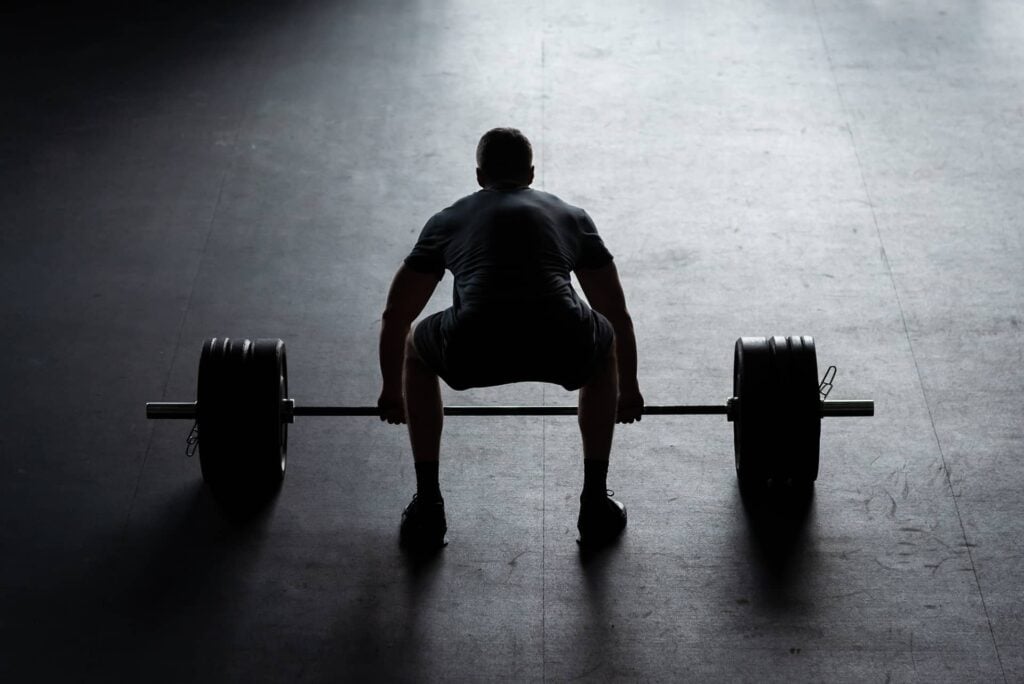Having a complete list of powerlifting exercises will help you design an effective workout plan for yourself or your clients.
In this article, I’ve rounded up around 30-40 exercises, including the major and supportive lifts that you can use to design a powerlifting training plan.
The major lifts will help you increase your strength and mass, and supportive lifts will improve stability and balance and correct weaknesses.
Related: 12-Week Powerlifting Program With PDF
The Ultimate List of Powerlifting Exercises
The Big Three Lifts
- Barbell Bench Press
- Barbell Back Squat
- Conventional Deadlift
List of accessory exercises for Bench Press
- Overhead Press
- Pin Press
- Spoto Press
- Tate Press
- Close Grip Bench Press
- Deficit Push-up
- Push Press
- Cable Fly
- Incline Bench Press
- Hammer Machine Chest Press
Supportive Exercises for Back Squat
- Back Squat with Pause
- Pin Squat
- Glute-Ham Raise
- Leg Press
- Dumbbell Deficit Sumo Squat
- Smith Machine Sumo Squat
- Front Lunges
- Reverse Lunges
- Step-up
- Leg Curl
Supportive Exercises for Deadlift
- Barbell Good Morning
- Reverse Hyperextension
- Deficit Deadlift
- Rack Pull
- Hip Thrust
- Cable Pull Through
- Romanian Deadlift
- Kettlebell Swings
- Hang Clean
- Shrug
1. Barbell Bench Press

The bench press is one of the three lifts performed in the Powerlifting.
It is an excellent exercise to develop upper body strength and mass, especially in chest muscles.
The main goal of doing it in powerlifting is to increase the 1RM (one-rep maximum) while beefing up the chest mass.
As for technique, The International Powerlifting Association has set some rules for performing the bench press, and if you break them, you’ll be disqualified.
Here are some major rules you’ll need to keep in mind while performing it:1 Powerlifting Bench Press Rules – Wikipedia
- It would be best to lay backward with your shoulders and buttocks resting on the flat bench surface.
- You must keep your feet firmly on the flat surface or floor.
- You must maintain an 81 cm distance between your hands, measured between the forefingers.
You can learn more practically about it in the gym where powerlifters train.
Alright! Once you do the bench press, it’s time to perform additional exercises to improve your balance, form, and functional movement.
1. Pin Press
The pin press reinforces the chest and tricep muscles. It is similar to the bench press but performed with lighter weights.
To perform this movement:
- Set the bar on the pin and lay down under it on a flat bench.
- Grip the bar firmly with your hands slightly wider than shoulder-width apart.
- Unrack the bar and hold it just above your chest.
- Brace your abdominal muscles and maintain a slight arch in your lower back.
- Press the bar over your chest until your arms are fully straight.
2. Spoto Press
Spoto press is an isometric movement in which you hold the bar a couple of inches above your chest for two to ten seconds before pressing it.
It is an excellent workout for scaling up for a greater one-rep max (1RM). It increases the ability to hold the weight for the maximum time under tension.
3. Dumbbell Tate press
The dumbbell Tate press strengthens triceps muscles and helps you improve your bench press.
Sturdy triceps let you press more weight during the bench and increase your 1RM.
You can do it by lying on a flat bench. Just grab a pair of dumbbells, hold them in the initial position of the press, and lower them toward your upper chest.
4. Close Grip Bench Press
The close grip bench press reinforces your triceps and chest muscles simultaneously, boosting your lifting strength. You can do it to increase your one-rep max.
To perform this movement, sit on a flat bench and grab the bar with your hands slightly shorter than hip-width apart. Unrack the bar and hold it over your chest. Now, press it over your chest until your arms are straight.
2. Barbell Back Squat

The barbell back squat is a lower-body strengthening exercise primarily targeting the quadriceps (quads). It is one of the “Big Three lifts” performed in a powerlifting competition.
Squatting is a great way to boost muscle strength and hypertrophy. Moreover, it improves athletic movements such as jumping, running, and lifting. 2Myer GD, Kushner AM, Brent JL, et al. The back squat: A proposed assessment of functional deficits and technical factors that limit performance. Strength Cond J. 2014;36(6):4-27. doi:10.1519/SSC.0000000000000103
There are some rules you need to follow while doing powerlifting training. For examples:
- You must squat down until the top surface of your legs at the hip joint is lower than the top of your knees”.3 IPF rulebook, 2019, Powerlifting Sports
- It would be best not to touch your knees with your elbows or upper arms when you squat down or return to the starting position.
If you want to perform the squat with heavier weights and increase your one-rep max, you can do the below auxiliary exercises:
1. Glute-Ham Raise
The glute-ham raise is a compound movement that strengthens posterior chain muscles, especially the lower back, hamstrings, and glutes.
Stronger posterior chain muscles enable you to lift more weights, reduce the risk of injuries, and increase your one-rep max.
2. Lunge Variations
Lunges are great supportive exercises for scaling up 1RM. They have various types, such as forward lunges, reverse lunges, and in-line lunges.
You can do them with dumbbells, barbells, and kettlebells – depending on what suits you best.
3. Paused Back Squat
If you want to maximize your one-rep squat, you can do rest-pause squats after or before the main lift. Doing back squats with a pause allows for greater volume lifted via increased repetitions compared to a traditional squat in trained women.4 Korak, John A et al. “Effect of a rest-pause vs. traditional squat on electromyography and lifting volume in trained women.” European Journal of Applied Physiology vol. 118,7 (2018): 1309-1314. doi:10.1007/s00421-018-3863-6
Moreover, it also increases muscle mass and time under tension and enhances knee extensor strength.
During this movement, you need to hold your body in the squat position for five to ten seconds (depending on your muscle endurance) before you stand back.
4. Dumbbell Step-up
The dumbbell step-up is an effective lower-body workout that strengthens the quads, hamstrings, and glutes simultaneously. It can help you improve your balance and may increase your 1RM.
To perform this movement, grab one dumbbell in each hand and stand upright in front of a flat bench or box, keep your arms straight at your sides. And then step up your right foot on the bench followed by the left one.
3. Barbell Deadlift

The deadlift is known as the king of all lifts. It works on multiple muscles simultaneously, including the legs, glutes, back, abs, and shoulders.
It helps build resilience, promotes muscle growth, and improves functional fitness.
If you want to improve your deadlifting performance, you can do the following exercises:
1. Barbell Good Morning
Good-morning exercise works on the hamstring, glutes, and lower back and improves strength and mobility.
Moreover, it reduces the risk of low back injuries and enables you to lift more weight during the deadlift exercises.
You can do this movement with all equipment, such as a kettlebell, barbell, and dumbbell.
The video below shows you how to perform Good Morning with a barbell.
2. Reverse Hyperextension
The reverse hyperextension eases lower back muscles after intense deadlifting. It strengthens the glutes, hamstrings, and especially the lower back.
A study suggests that reverse hyperextension significantly increases the strength of the posterior chain muscles compared to hyperextension.5 Cuthbert M, Ripley NJ, Suchomel TJ, Alejo R, McMahon JJ, Comfort P. Electromyographical Differences Between the Hyperextension and Reverse-Hyperextension. J Strength Cond Res. 2021 Jun 1;35(6):1477-1483. doi: 10.1519/JSC.0000000000004049. PMID: 34027916. Having firm posterior chain muscles enables you to pull more weight and reduce the risk of injuries.
3. Deficit Deadlift
The deficit deadlift is another exercise that will help you enhance your deadlifting and scale up your one-rep max.
You can follow the instructions given in this video to perform it effectively.
4. Romanian Deadlifts
The Romanian deadlift is equally effective as a deficit deadlift and helps you enhance strength and mobility in your posterior chain muscles.
You can also do it as a supportive lift after the main deadlift workout to improve your overall performance.
Download The Powerlifting Exercises List PDF
You can also download the PDF of the list of powerlifting exercises so you can use it whenever you like. This list will also help you create a workout program to develop ultimate strength.
You can also do these twenty-five abs exercises to reinforce your core. A strong core helps you lift more during the powerlifting exercises while minimizing the risk of injuries.
References
- 1Powerlifting Bench Press Rules – Wikipedia
- 2Myer GD, Kushner AM, Brent JL, et al. The back squat: A proposed assessment of functional deficits and technical factors that limit performance. Strength Cond J. 2014;36(6):4-27. doi:10.1519/SSC.0000000000000103
- 3IPF rulebook, 2019, Powerlifting Sports
- 4Korak, John A et al. “Effect of a rest-pause vs. traditional squat on electromyography and lifting volume in trained women.” European Journal of Applied Physiology vol. 118,7 (2018): 1309-1314. doi:10.1007/s00421-018-3863-6
- 5Cuthbert M, Ripley NJ, Suchomel TJ, Alejo R, McMahon JJ, Comfort P. Electromyographical Differences Between the Hyperextension and Reverse-Hyperextension. J Strength Cond Res. 2021 Jun 1;35(6):1477-1483. doi: 10.1519/JSC.0000000000004049. PMID: 34027916.






